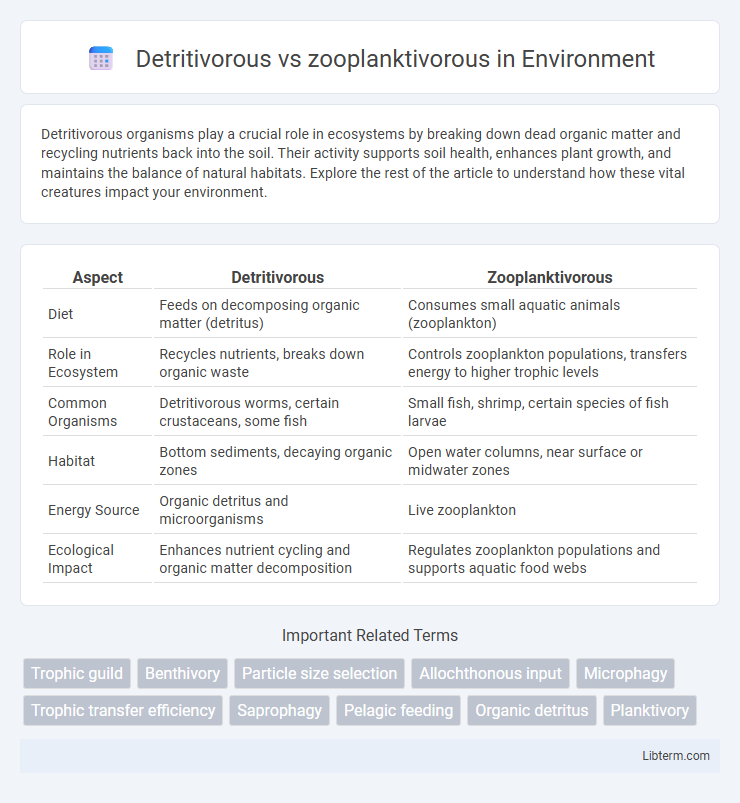Detritivorous organisms play a crucial role in ecosystems by breaking down dead organic matter and recycling nutrients back into the soil. Their activity supports soil health, enhances plant growth, and maintains the balance of natural habitats. Explore the rest of the article to understand how these vital creatures impact your environment.
Table of Comparison
| Aspect | Detritivorous | Zooplanktivorous |
|---|---|---|
| Diet | Feeds on decomposing organic matter (detritus) | Consumes small aquatic animals (zooplankton) |
| Role in Ecosystem | Recycles nutrients, breaks down organic waste | Controls zooplankton populations, transfers energy to higher trophic levels |
| Common Organisms | Detritivorous worms, certain crustaceans, some fish | Small fish, shrimp, certain species of fish larvae |
| Habitat | Bottom sediments, decaying organic zones | Open water columns, near surface or midwater zones |
| Energy Source | Organic detritus and microorganisms | Live zooplankton |
| Ecological Impact | Enhances nutrient cycling and organic matter decomposition | Regulates zooplankton populations and supports aquatic food webs |
Introduction to Detritivorous and Zooplanktivorous Feeding
Detritivorous organisms feed primarily on decomposing organic matter, playing a crucial role in nutrient recycling within ecosystems by breaking down dead plant and animal material. Zooplanktivorous species consume zooplankton, microscopic animals suspended in aquatic environments, which are rich in protein and essential nutrients, supporting higher trophic levels. Both feeding strategies are vital for energy transfer and maintaining ecological balance in aquatic food webs.
Defining Detritivorous Organisms
Detritivorous organisms primarily consume decomposing organic matter known as detritus, including dead plant and animal material, fungi, and bacteria, playing a critical role in nutrient cycling and ecosystem health. These organisms, such as earthworms, certain aquatic insects, and some fish species, help break down complex organic compounds into simpler substances, facilitating nutrient availability for other organisms. In contrast, zooplanktivorous species feed on zooplankton, microscopic animal plankton, positioning themselves differently within aquatic food webs.
Understanding Zooplanktivorous Species
Zooplanktivorous species primarily consume zooplankton, microscopic animals drifting in aquatic environments, playing a crucial role in aquatic food webs by transferring energy from primary producers to higher trophic levels. These species exhibit specialized feeding adaptations such as fine gill rakers or filter-feeding mechanisms to effectively capture zooplankton, distinguishing them from detritivorous species that consume decomposed organic material. Understanding zooplanktivorous dietary habits is essential for assessing their impact on zooplankton populations and overall ecosystem dynamics.
Key Differences in Feeding Habits
Detritivorous organisms primarily consume decomposing organic matter and dead plant or animal material, playing a crucial role in nutrient recycling within ecosystems. Zooplanktivorous species specialize in feeding on zooplankton, small drifting animals in aquatic environments, which influences energy transfer in food webs. The key difference lies in detritivores processing detritus, whereas zooplanktivores target live microscopic animals as their main food source.
Ecological Roles in Aquatic Ecosystems
Detritivorous aquatic organisms play a crucial role in breaking down organic matter, recycling nutrients, and maintaining water quality by consuming decomposing plant and animal material. Zooplanktivorous species primarily feed on zooplankton, controlling plankton populations and serving as vital links in aquatic food webs that transfer energy to higher trophic levels such as fish. Both functional groups contribute to ecosystem stability and nutrient cycling but do so through distinct feeding strategies that support biodiversity and aquatic productivity.
Impact on Nutrient Cycling
Detritivorous organisms play a crucial role in nutrient cycling by breaking down organic matter and releasing essential nutrients such as nitrogen and phosphorus back into the ecosystem, promoting soil fertility and primary productivity. Zooplanktivorous species influence nutrient cycling by regulating zooplankton populations, which affects the grazing pressure on phytoplankton and subsequently the rate of nutrient uptake and recycling in aquatic environments. Both feeding strategies contribute to maintaining ecosystem stability but operate through distinct mechanisms impacting nutrient availability and energy flow within food webs.
Adaptations for Diet Specialization
Detritivorous species exhibit morphological adaptations such as specialized mouthparts and elongated digestive tracts to efficiently process decomposing organic matter. Zooplanktivorous organisms possess highly sensitive gill rakers and enhanced visual acuity to capture and filter tiny planktonic animals from the water column. These distinct feeding adaptations optimize nutrient extraction and survival within their respective ecological niches.
Examples of Detritivores and Zooplanktivores
Detritivorous organisms, such as earthworms, woodlice, and certain species of catfish, consume decomposing organic matter, playing a crucial role in nutrient recycling in ecosystems. Zooplanktivorous species, including herring, anchovies, and certain young salmon, feed primarily on zooplankton like copepods and krill, serving as a vital link in aquatic food chains. Both detritivores and zooplanktivores contribute significantly to ecosystem stability by facilitating energy transfer and organic matter breakdown.
Influence on Food Web Dynamics
Detritivorous organisms process organic matter, recycling nutrients and supporting primary productivity, while zooplanktivorous species regulate zooplankton populations, affecting predator-prey interactions and energy transfer efficiency. The balance between detritivory and zooplanktivory influences trophic cascades, with detritivores promoting nutrient availability for phytoplankton growth and zooplanktivores controlling herbivorous zooplankton that consume primary producers. This dynamic interplay shapes the structure, stability, and resilience of aquatic food webs across freshwater and marine ecosystems.
Evolutionary Significance and Future Research
Detritivorous and zooplanktivorous feeding strategies highlight distinct evolutionary adaptations in aquatic ecosystems, with detritivores specializing in organic matter decomposition and zooplanktivores targeting live planktonic prey, driving niche differentiation and biodiversity. Understanding these strategies offers insights into energy flow and nutrient cycling critical for ecosystem stability and resilience. Future research should prioritize genomic and functional analyses to unravel adaptive mechanisms, evolutionary pathways, and responses to environmental changes such as climate-driven shifts in resource availability.
Detritivorous Infographic

 libterm.com
libterm.com